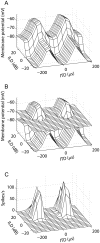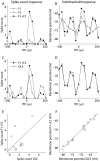Multiplicative auditory spatial receptive fields created by a hierarchy of population codes
- PMID: 19956693
- PMCID: PMC2776990
- DOI: 10.1371/journal.pone.0008015
Multiplicative auditory spatial receptive fields created by a hierarchy of population codes
Abstract
A multiplicative combination of tuning to interaural time difference (ITD) and interaural level difference (ILD) contributes to the generation of spatially selective auditory neurons in the owl's midbrain. Previous analyses of multiplicative responses in the owl have not taken into consideration the frequency-dependence of ITD and ILD cues that occur under natural listening conditions. Here, we present a model for the responses of ITD- and ILD-sensitive neurons in the barn owl's inferior colliculus which satisfies constraints raised by experimental data on frequency convergence, multiplicative interaction of ITD and ILD, and response properties of afferent neurons. We propose that multiplication between ITD- and ILD-dependent signals occurs only within frequency channels and that frequency integration occurs using a linear-threshold mechanism. The model reproduces the experimentally observed nonlinear responses to ITD and ILD in the inferior colliculus, with greater accuracy than previous models. We show that linear-threshold frequency integration allows the system to represent multiple sound sources with natural sound localization cues, whereas multiplicative frequency integration does not. Nonlinear responses in the owl's inferior colliculus can thus be generated using a combination of cellular and network mechanisms, showing that multiple elements of previous theories can be combined in a single system.
Conflict of interest statement
Figures











Similar articles
-
Auditory spatial receptive fields created by multiplication.Science. 2001 Apr 13;292(5515):249-52. doi: 10.1126/science.1059201. Science. 2001. PMID: 11303092
-
Emergence of multiplicative auditory responses in the midbrain of the barn owl.J Neurophysiol. 2007 Sep;98(3):1181-93. doi: 10.1152/jn.00370.2007. Epub 2007 Jul 5. J Neurophysiol. 2007. PMID: 17615132 Free PMC article.
-
From spectrum to space: the contribution of level difference cues to spatial receptive fields in the barn owl inferior colliculus.J Neurosci. 2002 Jan 1;22(1):284-93. doi: 10.1523/JNEUROSCI.22-01-00284.2002. J Neurosci. 2002. PMID: 11756512 Free PMC article.
-
The synthesis and use of the owl's auditory space map.Biol Cybern. 2003 Nov;89(5):378-87. doi: 10.1007/s00422-003-0443-5. Epub 2003 Dec 4. Biol Cybern. 2003. PMID: 14669018 Review.
-
The neural coding of auditory space.J Exp Biol. 1989 Sep;146:307-22. doi: 10.1242/jeb.146.1.307. J Exp Biol. 1989. PMID: 2689568 Review.
Cited by
-
Vowel and formant representation in the human auditory speech cortex.Neuron. 2023 Jul 5;111(13):2105-2118.e4. doi: 10.1016/j.neuron.2023.04.004. Epub 2023 Apr 26. Neuron. 2023. PMID: 37105171 Free PMC article.
-
Optimal nonlinear cue integration for sound localization.J Comput Neurosci. 2017 Feb;42(1):37-52. doi: 10.1007/s10827-016-0626-4. Epub 2016 Oct 6. J Comput Neurosci. 2017. PMID: 27714569 Free PMC article.
-
Linear processing of interaural level difference underlies spatial tuning in the nucleus of the brachium of the inferior colliculus.J Neurosci. 2013 Feb 27;33(9):3891-904. doi: 10.1523/JNEUROSCI.3437-12.2013. J Neurosci. 2013. PMID: 23447600 Free PMC article.
-
Nonlinear Spatial Integration Underlies the Diversity of Retinal Ganglion Cell Responses to Natural Images.J Neurosci. 2021 Apr 14;41(15):3479-3498. doi: 10.1523/JNEUROSCI.3075-20.2021. Epub 2021 Mar 4. J Neurosci. 2021. PMID: 33664129 Free PMC article.
-
Side peak suppression in responses of an across-frequency integration model to stimuli of varying bandwidth as demonstrated analytically and by implementation.J Comput Neurosci. 2014 Feb;36(1):1-17. doi: 10.1007/s10827-013-0460-x. Epub 2013 May 29. J Comput Neurosci. 2014. PMID: 23715909
References
-
- Knudsen EI, Blasdel GG, Konishi M. Sound localization by the barn owl (Tyto alba) measured with the search coil technique. J Comp Phys A. 1979;133:1–11.
-
- Knudsen EI, Du Lac S, Esterly SD. Computational maps in the brain. Annu Rev Neurosci. 1987;10:41–65. - PubMed
-
- Konishi M. Coding of auditory space. Annu Rev Neurosci. 2003;26:31–55. - PubMed
Publication types
MeSH terms
Grants and funding
LinkOut - more resources
Full Text Sources
Other Literature Sources

